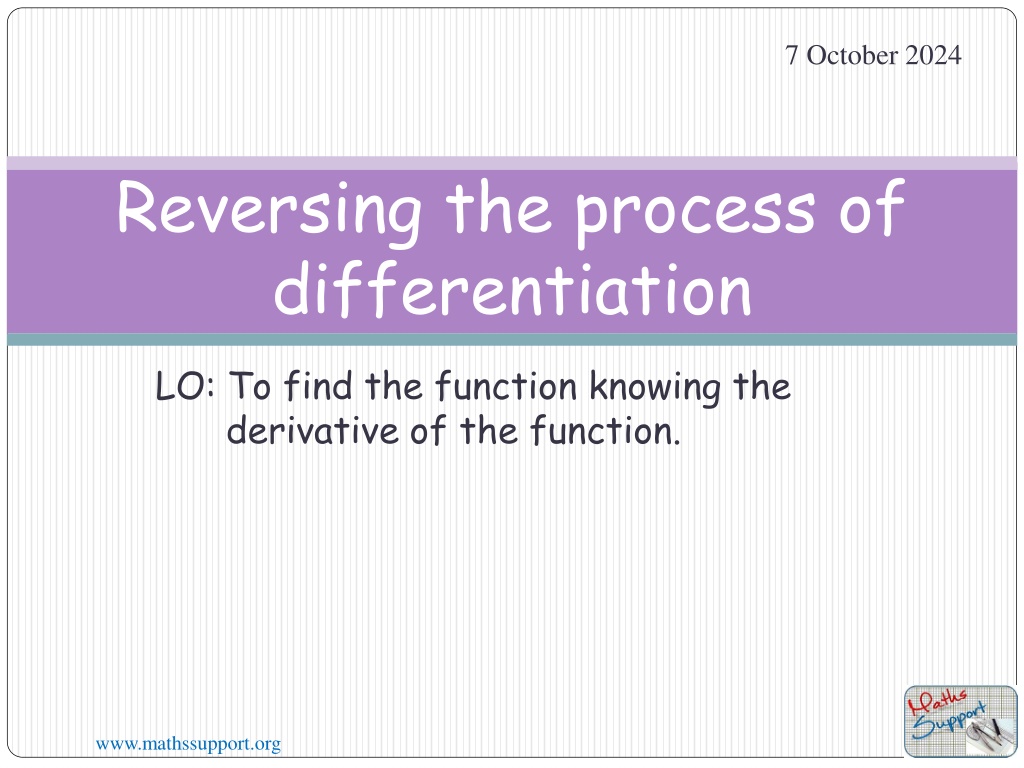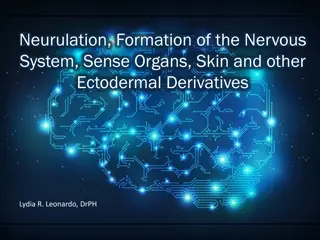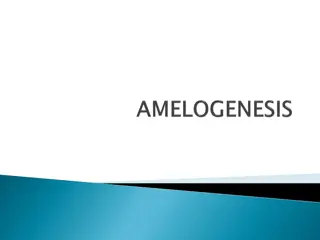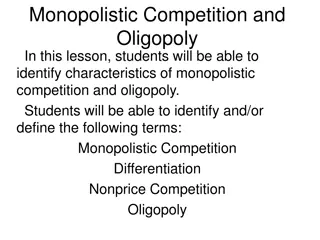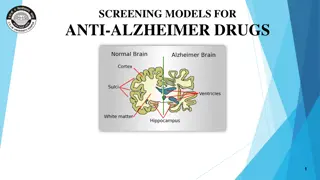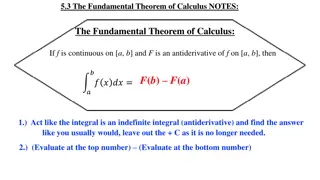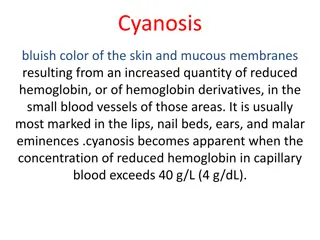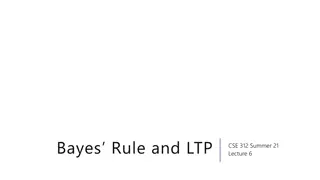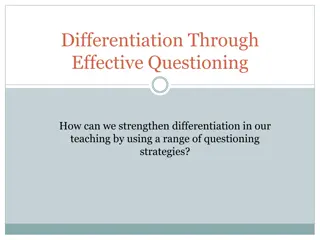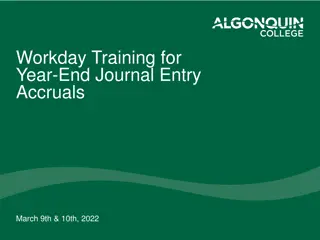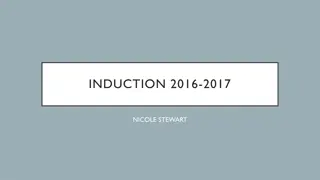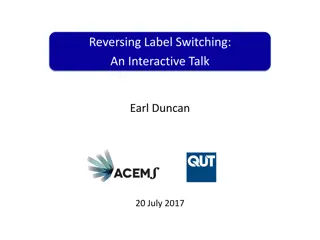Understanding the Process of Reversing Differentiation
Reversing the differentiation process involves finding the function knowing its derivative. By increasing the exponent by 1, dividing by the new exponent, and adding a constant term, the antiderivative of a function can be determined. The general form of an antiderivative involves adding a constant, making it flexible for various functions. Examples and explanations of antiderivatives are provided to enhance understanding and application in calculus.
Download Presentation

Please find below an Image/Link to download the presentation.
The content on the website is provided AS IS for your information and personal use only. It may not be sold, licensed, or shared on other websites without obtaining consent from the author. Download presentation by click this link. If you encounter any issues during the download, it is possible that the publisher has removed the file from their server.
E N D
Presentation Transcript
7 October 2024 Reversing the process of differentiation LO: To find the function knowing the derivative of the function. www.mathssupport.org
Reversing the process of differentiation When differentiating powers of x, y = xn, we multiply by the original exponent and then drop the exponent by one. We can write this process as follows: nxn reduce the exponent by 1 multiply by the the original exponent xn nxn-1 Reversing the process of differentiation given above would give nxn xn increase the exponent by 1 divide by the exponent nxn-1 dy dx Suppose we are given the derivative = xnand asked to find y in terms of x. increase the exponent by 1 xn+1 ??+1 ? + 1 divide by the exponent xn www.mathssupport.org
Reversing the process of differentiation The process of finding a function f(x) whose derivative is f (x) is called anti-differentiation, which relates to integration. For example, What is the derivative of x2 with respect to x? If you anti-differentiate 2xwith respect to x 2x x2 What is the derivative of x2 + 3with respect to x? What is the derivative of x2 5with respect to x? You can easily see that 2xis the derivative for any function of the formx2 + c, where c is any real number The antiderivative of all of them is the same 2x 2x This set, or family, of all anti-derivatives of a function is called the indefinite integral We therefore have to write y = x2 + c. www.mathssupport.org
Reversing the process of differentiation General form of an Antiderivative Let Fbe an antiderivative of f over an interval I, then i. For each constant C, the function F(x) + Cis also an antiderivative of f over I; ii. If G is an antiderivative of foverI, there is a constant C to which G(x) = F(x) + Cover I. In other words, the most general form of the antiderivative of fover I is F(x) + C www.mathssupport.org
Reversing the process of differentiation dy dx For example: Adding 1 to the power and dividing by the new power gives: 2 If =6 find in terms of . y x x 6 3 =3 = 2x3 y x This is not the complete solution, however, because if we differentiated y = 2x3 + 1, ory = 2x3 3, or y = 2x3 + any constant dy x dx we would also get 2 = 6 We therefore have to write y = 2x3 + c. In general: The antiderivative of xnare given by 1 ? + 1??+1+ ? www.mathssupport.org
Reversing the process of differentiation Find the antiderivative of the function x10: Adding 1 to the power and dividing by the new power gives: 1 10 + 1?10+1+ ? 1 11?11+ ? = Find the antiderivative of the function 1 Adding 1 to the power and dividing by the new power gives: 1 5 + 1? 5+1+ ? 1 4? 4+ ? = x-5 ?5 1 = 4?4+ ? = www.mathssupport.org
Reversing the process of differentiation Find the antiderivative of the function Rewriting using rational exponents 4?3 3 4 = ? Adding 1 to the power and dividing by the new power gives: 1 3 4+ 1 =1 7 4 =4 7? 3 4+1+ ? ? 7 4+ ? ? 7 4+ ? www.mathssupport.org
Reversing the process of differentiation Antidifferentiation is also known as indefinite integration And is denoted with an integral symbol, ?? IfF (x) = f(x), we write ? ? ?? = ? ? + ? Constant of integration integrand Variable of integration Is read as: The antiderivative of fwith respect to x The integral of fwith respect to x ? ? ?? www.mathssupport.org
Rules to find the indefinite integrals Power rule 1 ? + 1??+1+ ?,? 1 ???? = Constant rule ??? = ?? + ?, Constant multiple rule ??(?)?? = ? ?(?)?? Sum or difference rule = ? ? ?? ? ? ?? ?(?) ?(?)?? www.mathssupport.org
Indefinite integrals Find the indefinite integral Applying the power rule ?6?? 1 ? + 1??+1+ ?,? 1 ???? = 1 6 + 1?6+1+ ? =1 7?7+ ? Find the indefinite integral Applying the constant rule 4?? ??? = ?? + ?, Thedttells you that the variable of integration is t = 4? + ?, www.mathssupport.org
Indefinite integrals Find the indefinite integral Applying the constant multiple rule 3?5?? ??(?)?? = ? ?(?)?? = 3 ?5?? 1 5 + 1?5+1+ ? = 3 =1 2?6+ ? www.mathssupport.org
Indefinite integrals Find the indefinite integral Applying the sum or difference rule (3?4+6?2+ 2)?? ?(?) ?(?)?? = ? ? ?? ? ? ?? = 3?4?? + 6?2?? + 2?? Applying the constant multiple rule = 3 ?4?? +6 ?2?? + 2?? 1 1 Applying the power rule and constant rule 4 + 1?4+1 2 + 1?2+1 = 3 +6 +2? + ? =3 5?5+ 2?3+ 2? + ? www.mathssupport.org
Thank you for using resources from A close up of a cage Description automatically generated For more resources visit our website https://www.mathssupport.org If you have a special request, drop us an email info@mathssupport.org www.mathssupport.org
